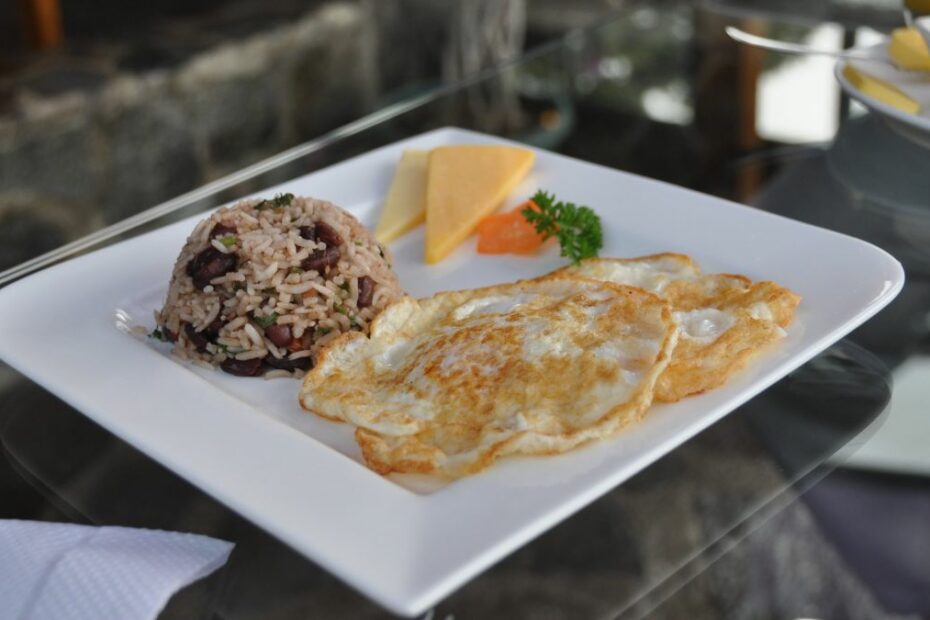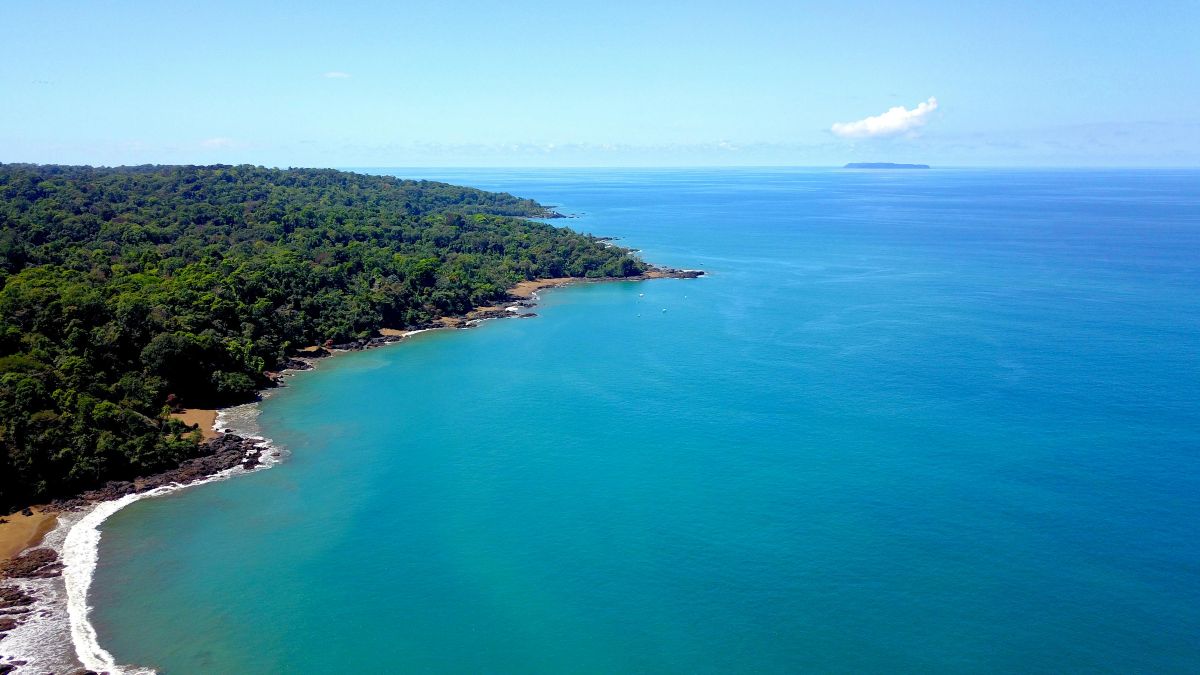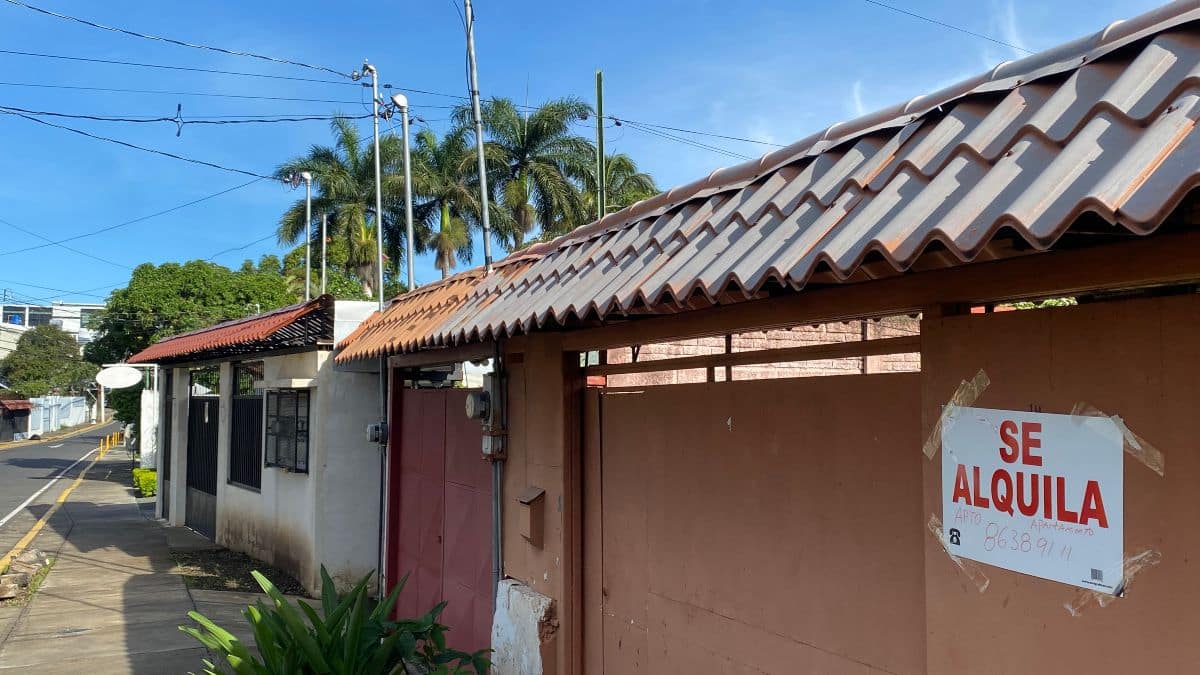Costa Rica and Nicaragua both claim gallo pinto as a national treasure, and say it was invented in their land. But which country’s gallo pinto is actually better? This article contains a link (or links) to Amazon, from which, as an Amazon Associate, this website will earn a small commission if you make any purchases.
Anybody who’s been knocking around the bottom half of Central America knows about the Great Gallo Pinto Question. Well – let’s scrub Panama from this equation.
Panama has better things to do than mess around with this nonsense. But in the other two countries in the bottom half, Costa Rica and Nicaragua, the gallo pinto question is important.
If you’re not from around these parts, I’ll explain. We’re talking serious stuff, here. We’re talking gallo pinto.
Gallo pinto is, in the words of JP Sears, “an exquisite combination of beans and rice” that, to paraphrase, you’ll never grow tired of eating before the first time you have it.
Considered the breakfast of champions by Costa Ricans, Nicaraguans, and tourists/expats everywhere who should know better, gallo pinto is a national symbol.
View this post on Instagram
And that’s the issue.
This breakfast is a national symbol for both Costa Rica and Nicaragua. Each country is – how can I say? – mighty annoyed the other claims gallo pinto as their own.
An expression in Costa Rica describing the Costa Rican-ness of something is “mas Tico que el gallo pinto” (more Costa Rican than gallo pinto).
In Nicaragua, you can buy t-shirts that say “100% nicaragüense como el gallo pinto y el Rio San Juan” (100% Nicaraguan like gallo pinto and the Rio San Juan).
The Rio San Juan is another article altogether. But the long story short is that it’s the river that makes up much of the border between Costa Rica and Nicaragua. The whole river is Nicaraguan, a source of irritation to the Ticos. Tension exists.
So combining gallo pinto with a geopolitical issue like the San Juan on a t-shirt you can buy in any souvenir place alongside your Toña tank top is a blatant dig. And everyone knows it.
One thing nobody know for sure, however, is whether gallo pinto is Costa Rican or Nicaraguan.
Costa Rican chef and food writer Marco Gonzalez of Mango Catering says, “Nicaraguans say pinto originated on their Caribbean coast and Costa Ricans believe it started in the southern sections of San Jose.“
But gallo pinto might not even be from either country. Costa Rica and Nicaragua don’t have the monopoly on beans and rice. People eat rice and beans all over Central America and the Caribbean, says Gonzalez.
“They call it casamiento in Honduras, and you have the infamous Moros y Cristianos which originated in Spain and is now a staple of Cuban cuisine.“
View this post on Instagram
So what’s the big deal with gallo pinto?
Great question. Two countries that share such a narrow strip of land, speak the same language and have more or less the same heritage should share gallo pinto with each other with pleasure and joy.
But they can’t. Neither country can quite accept the other has the nerve to eat gallo pinto too.
And people are protective of “their” pinto. Super protective. I’ve never once heard a Tico, in real life, declare they prefer Nicaraguan gallo pinto and vice versa. This can’t be a coincidence. I mean gallo pinto is not even that nice – JP Sears was right.
Back in 2017, Sears almost faced public execution in Costa Rica for being less than exuberant about gallo pinto (among other things). Maybe if he’d been talking about pinto in Nicaragua, they would have executed him. They’re a tougher crowd across the Rio San Juan.
And then there’s British TV chef Jamie Oliver. After his first visit to Costa Rica in 2016, he got flamed for messing with the gallo pinto. He had to escape back to the safety of the Four Seasons (or wherever he was staying) after daring to prepare this controversial breakfast. Ticos weren’t happy with how he prepared it – maybe it was the tomato salsa, which no-one in Costa Rica uses on gallo pinto in real life. Who knows?
interesting use of ingredients, but in CR we usually use a different set for the #gallopinto
— César Sánchez (@cesaresanchezm) May 14, 2016
PersonalIy speaking, I don’t even like gallo pinto.
I don’t care if it’s your Nica pinto or Tico pinto… whatever. They both suck, I gotta say it. Sorry, I’m not a fan.
I mean beans and rice? Rice and beans? For breakfast?? You gotta be kidding. A blander combination in life you cannot find. You can add cilantro and herbs and natilla and fry an egg and put chorizo or cheese next to pinto but you’re still eating beans and rice. Or rice and beans.
Nothing wrong about that at all. I like beans (that’s a dirty lie – I hate beans, but I live in Central America so gotta play the part, I guess) and I like rice. But not together. And not for breakfast. If I’m eating breakfast at all, which is a rare thing for me, I like Cheerios. Or eggs, which offer so many more health benefits than pinto, and taste better to boot.
But what gets me are all my fellow immigrants from the north waxing lyrical about this stuff. There’s nothing worse than “going native”. No-one respects you for going native. Gringos who rattle on about how gallo pinto is the finest breakfast in the world deserve a special place in purgatory. They are pretending. Being something they’re not. No Nicaraguan or Costa Rican will respect you more because you gush on about a dish you’d never eat in your country of origin. Like I won’t respect any non-Brit more because they like steak and kidney pie or jellied eels.
Consider how many Costa Rican or Nicaraguan restaurants exist in your hometown. Yeah, right? They’re with all the British restaurants. There’s a reason for that. Like British food, Costa Rican and Nicaraguan cuisine have no discernible reputation. And the standard bearer of both countries cuisines is gallo pinto.
Don’t get me wrong, haters – I like plenty of Costa Rican, Nicaraguan, and even British food. But none of it is Mexican, Peruvian, Italian or Lebanese is what I’m saying.
Costa Rica and Nicaragua should work together to promote a new, delicious breakfast (like switching the beans out for teeny tiny bits of pork – that would be awesome), instead of arguing with each other over who owns gallo pinto.
View this post on Instagram
It’s all in the beans…
Which brings me to my next point, and the point of this whole article. What’s the difference between Costa Rican gallo pinto and Nicaraguan gallo pinto? When people say they prefer the pinto of their own country are they being stubborn or honest? Has pinto evolved in different ways on either side of the Rio San Juan?
And now the mother of questions. Which gallo pinto is better, Tico or Nica? You already have my answer. I don’t like either. But does one suck less than the other?
The fundamental difference is with the beans. Nicaraguan pinto has red beans while Costa Rican pinto has black beans. The Nicaraguan pinto is more pleasing to the eye if not the taste buds.
The red beans of the Nicaraguan pinto seem to be not so mushy either. They seem firmer to the touch. I like that. Black beans all soft and mushy mixed with rice gives me the shivers. At least with firmer beans, you can remove them and eat the rice on its own.
The reason is with Costa Rican pinto, they sauté the beans and rice together. While with Nicaraguan pinto, they prepare the rice first and add the beans later to keep them firmer.
“I prefer to use red beans and only natural spices including cumin, ground coriander, soy sauce, tomatoes, a little coffee and a hint of cocoa and a little lemon and never use Lizano.” Marco Gonzalez, chef
And you know, for me, Nica pinto looks nicer. I acknowledged that already, but it’s worth repeating. Nicaraguan pinto looks like something someone who likes beans – i.e., not me – would like to eat. Tico pinto looks like some kind of purple and white sludge. My opinion as a non-lover of beans.
How To Make Gallo Pinto, The Recipe for Nicaragua’s Signature Dish https://t.co/OFwQnqWohc #yummy #food pic.twitter.com/JNQOee81Tv
— Food|Wine|Life™ (@HomeOfGastro) April 3, 2018
And the condiments…
Red beans or black beans are the first, crucial difference. The second difference is that Tico pinto needs Salsa Lizano to be edible. Now, personally, I love (well, like) Salsa Lizano. It’s one of the top twenty reasons to live in Costa Rica (although Lizano aficionados can buy their favorite sauce on Amazon) and for sure the number one reason to eat gallo pinto.
Eating gallo pinto to get more Salsa Lizano in your life, even if you don’t like pinto, is something I find acceptable to do. And the Lizano is great at hiding the taste of the pinto.
Nicaraguan gallo pinto needs no gimmicks like Salsa Lizano.
Nica pinto comes purer. Beans and rice cooked apart to avoid mushiness and you can taste the fresh cilantro and other herbs more. Nicaraguan pinto tastes fresher and nicer. And I say this without even liking pinto and as someone who lives in Costa Rica.
So for me, someone who spent most of this article bashing gallo pinto in both countries, Nicaraguan gallo pinto is the winner. I’m no authority at all, so is someone like me, who doesn’t like pinto, the best qualified to comment?
I didn’t think so. Let’s return to the experts.
View this post on Instagram
Chef Marco Gonzalez, ever the gentleman, sits on the fence here.
When asked which gallo pinto he prefers, he says, “I enjoy Tico-style better but I prefer to use red beans and only natural spices including cumin, ground coriander, soy sauce, tomatoes, a little coffee and a hint of cocoa and a little lemon and never use Lizano.“
Hmm. That sounds more like Nicaraguan pinto to me. Red beans? Check. Lack of Lizano? Double-check. When pressed on this, Gonzales laughs and says, “I guess you could say I like a combination of both ideas.“
Well played, sir.
My take from this is Gonzalez, an accomplished chef and renowned foodie in Costa Rica, prefers Nicaraguan gallo pinto but being a proud Tico, can’t admit this. I’ve been in Costa Rica a long time so I understand.
I will also say, his version of gallo pinto sounds delicious, even to a bean-hater like me. I can’t deny it. But then I know how good a chef he is.
Although this dish is typically served at breakfast, you can make it fit any meal! Check out our video on how to make gallo pinto. You’ll find the recipe at the end, so #CookLikeATico today and reply with your dish below! #StaySafe
📍: Costa Rica pic.twitter.com/d3KaAh4XIe
— Visit Costa Rica (@Visit_CostaRica) April 30, 2020
The gallo pinto test.
In 2015, Vivala, a now defunct lifestyle site for Latinas in the U.S., put the question to the test. They took gallo pinto from both a Nicaraguan and a Costa Rican restaurant in New York City (yes, I know I mentioned the lack of these restaurants earlier, but this is NYC, not the real world. You even get British restaurants in NYC ) and put them in front of a blindfolded trio comprising a Tico, a Nica, and a gringa. A bowl of Nica pinto and a bowl of Tico pinto.
The results were not surprising to me. Check the video out below.
All three contestants chose the Nicaraguan pinto. Even the Tico, who looked shocked once he realized what he’d done.
Manuel, the Costa Rican says, “I think the one on the right [the Nicaraguan pinto] was way better because it was more natural and you could feel the flavors. The other side [the Costa Rican pinto] had too much sauce.“
Lucky this guy was in the States and not Costa Rica when he uttered these words. Manuel proves my theory that gallo pinto in Costa Rica is an excuse for more Salsa Lizano and nothing else.
Gabriella, the American, agrees, although she says she has sauce on the right-hand pinto herself. Even with Lizano on her Nicaraguan pinto, she preferred it more. Or it could be as a gringa she doesn’t understand what the hell she’s talking about. That is always a possibility.
But for the sake of the argument, Nicaragua 2 Costa Rica 0.
It’s obvious that Saskia, the Nicaraguan, will make it a hat trick for her country and leave Costa Rica in the dust. She slams the point home.
“I thought both were really good, but my favorite was the right side,” she says. “Right side Nicaragua, left side, Costa Rica. For me, Nicaragua does it better.”
Pow.
Poor old Manuel. He’s in a bind. He might be in New York, far from his people, but his words will haunt him forever.
Like any good Tico, he can’t say the words Nicaraguan pinto is better. But his actions displayed his true feelings, and he needs to make his peace with that if he can.
From looking at this video, both pintos seem to have red beans, which dilutes these results somewhat. I assume that’s why Saskia said both were good. Any true Nicaraguan should have hated the Tico pinto. But she gets a pass as I’m sure she would have recognized a real black-beaned Costa Rican pinto.
So it’s official. I have verification of something I, a neutral and equal-opportunity gallo pinto hater, have always known to be true. Nicaraguan gallo pinto is better than Costa Rican gallo pinto.
But do you know what’s better than any gallo pinto? A bacon and sausage sandwich with HP Sauce. Beat that.
James Dyde is the editor of CentralAmerica.com. He lives in Escazu, Costa Rica.




